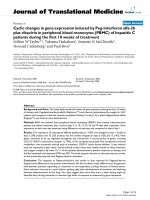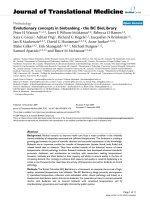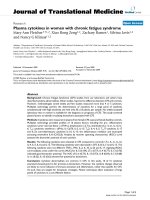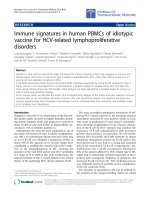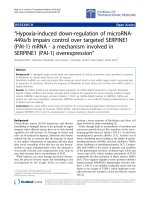Báo cáo hóa học: " Electron-Spin Precession in Dependence of the Orientation of the External Magnetic Field" docx
Bạn đang xem bản rút gọn của tài liệu. Xem và tải ngay bản đầy đủ của tài liệu tại đây (302.23 KB, 4 trang )
NANO PERSPECTIVES
Electron-Spin Precession in Dependence of the Orientation
of the External Magnetic Field
M. Idrish Miah
Received: 28 January 2009 / Accepted: 19 February 2009 / Published online: 13 March 2009
Ó to the authors 2009
Abstract Electron-spin dynamics in semiconductor-
based heterostructures has been investigated in oblique
magnetic fields. Spins are generated optically by a circu-
larly polarized light, and the dynamics of spins in
dependence of the orientation (h) of the magnetic field are
studied. The electron-spin precession frequency, polariza-
tion amplitude, and decay rate as a function of h are
obtained and the reasons for their dependences are dis-
cussed. From the measured data, the values of the
longitudinal and transverse components of the electron
g-factor are estimated and are found to be in good agree-
ment with those obtained in earlier investigations. The
possible mechanisms responsible for the observed effects
are also discussed.
Keywords Quantum well Á Spin dynamics Á
Electron g-factor
Introduction
Spintronics [1–3] has been built on the spin degree of
freedom and discusses the idea of using information carried
by the spin of the electron in electronic devices. Recently,
it has gained a lot of attention [4, 5], which may result in
devices with increased capability and functionality beyond
well-established storage or memory applications, already
implemented as giant magnetoresistance read-heads and
nonvolatile magnetic random access memory [6].
However, one of the important requirements necessary
in developing spintronic devices is the efficient generation
of spins in a semiconductor and transporting them reliably
over reasonable distances and then detecting them. Much
effort [5] has thus been spent in understanding these issues
in semiconductors. Generation of spin polarization usually
means creating a nonequilibrium spin population. This has
been achieved either by optical methods (circularly polar-
ized light, r, excitation) or by magnetic semiconductors, or
ferromagnetic contacts [2, 5, 7]. Several attempts, e.g.,
using ferromagnetic contacts to Si or InAs-based hetero-
structures (quantum wells, QWs), have resulted in low spin
injection effects due to the ‘‘conductivity mismatch’’ (more
precisely, a mismatch between effective resistances in the
metal and in semiconductor host) or other reasons. How-
ever, the spin generation by the optical methods has been
successful and the high spin-polarization of conductor band
electrons in semiconductor heterostructures has been
obtained [2]. Despite substantial progress in optical spin
generation, a further hurdle still remains in the spin
transport is the lack of a proper understanding of spin
dynamics in semiconductor-based heterostructures [5].
In the previous study [8], we focused on spin dynamics
in a transverse magnetic field in GaAs QWs by circularly
polarized photoluminescence (PL) measurements. We
studied the bias-dependent circular polarization of PL (P
r
)
and found that P
r
decays in the transverse magnetic field
with an enhancement of increasing the strength of the
negative bias. In this study, we extend our investigation
M. I. Miah (&)
Nanoscale Science and Technology Centre, Griffith University,
Nathan, Brisbane, QLD 4111, Australia
e-mail: m.miah@griffith.edu.au
M. I. Miah
School of Biomolecular and Physical Sciences,
Griffith University, Nathan, Brisbane, QLD 4111, Australia
M. I. Miah
Department of Physics, University of Chittagong,
Chittagong 4331, Bangladesh
123
Nanoscale Res Lett (2009) 4:588–591
DOI 10.1007/s11671-009-9283-0
and study the electron-spin dynamics in dependence of the
orientation (h) of the magnetic field. The spin precession
frequency, amplitude, and decay rate as a function of h are
estimated and their dependences on h are discussed. The
values of the longitudinal and transverse components of the
electron g-factor are also estimated.
Experimental
Investigated samples were GaAs double QWs separated by
a relatively thin (*20 nm) Al
0.3
Ga
0.7
As barrier. The
thickness of the QWs was varied from 8 to 10 nm. The
samples were grown on the Si-doped GaAs substrate using
the MBE growth technique. For the application of the
negative external bias of magnitude 2.5 V normal to the
heretostructure layers, the top surface of the sample was
coated with a semitransparent electrode. The sample was
mounted in a chip-carrier. We measured the PL excited by
ps pulses of a tunable Ti:sapphire laser with a repetition
rate of 76 MHz using a streak camera [8]. All the mea-
surements were done at liquid helium temperature by
placing the chip-carrier in a temperature-regulated cryostat.
The PL was excited directly to the exciton absorption band
and was detected with the small long-wavelength shift to
minimize the polarization losses. The exciting beam was
directed perpendicular to the 5-T magnetic field direction,
and the PL was detected in the backward direction. The h
with respect to the growth axis of the heterostructure was
changed by rotating the chip-carrier. The degree of circular
polarization P
r
was calculated using the relation
P
r
¼
I
r
þ
À I
r
À
ðÞ
I
r
þ
þ I
r
À
ðÞ
; ð1Þ
where I
r
þ
I
r
À
ðÞis the intensity of PL in the right(left),
r
?
(r
-
), circularly polarization under r
?
light excitation.
Results and Discussion
The PL was measured in the right (r
?
) and left (r
-
) cir-
cularly polarizations under r
?
light excitation in the
presence of external bias and magnetic field, and P
r
was
calculated from the measured data. Figure 1 shows the
kinetics of P
r
, where the variations in the dynamics of P
r
with the direction h of the magnetic field is clearly seen.
When h deviates from 90°, a non-oscillating weakly
damping component arises, with its amplitude growing
with the deviation angle. The amplitude of the oscillating
component also decreases. An analysis of the oscillating
part of the signal has been performed. The result has shown
that it can be well approximated by the damping harmonic
oscillating function [9]
P
r
¼ P
0
r
e
Àt
=
s
cos xtðÞ; ð2Þ
where P
r
0
= P
r
(0) is the amplitude, x is the oscillation
frequency, and s is the oscillation decay rate. Equation 2
allowed us to calculate the dependencies of P
0
r
; x, and s on
h. In Fig. 2, we plot the dependence of the oscillation
frequency x on h, where one can see that the deviation
from the exact Voigt configuration (h = 90°)is
accompanied by an increase in x. The increase in x
upon deviation of the magnetic field from the transverse
direction (h = 90°) is related to the anisotropy of the
electron g-factor resulting from the quantum size effect or
quantum confined (quantization) effect [10]. The splitting
between the spin sublevels of the free electron in quasi-
two-dimensional structures is given [11]by
De
r
¼ l
B
Hg
k
cos h
ÀÁ
2
þ g
?
sin hðÞ
2
no
1=2
; ð3Þ
where l
B
is the Bohr magneton, H is the magnetic field,
and g
k
and g
\
are the longitudinal and transverse compo-
nents of the electron g-factor, respectively. Equation 3 is
fitted to the data shown in Fig. 2 (solid line). From the fit,
we obtain the values of the corresponding components for
the QW structure. The values are g
k
= 0.25 and
g
\
= 0.20, agreeing well with the values obtained in the
earlier investigations [12–14].
Figure 3 shows the dependence of the initial oscillation
amplitude on the angle between the magnetic field and the
direction of observation. The changes in the amplitude of
the oscillations in oblique magnetic fields can be explained
as follows. As P
r
is determined by the orientation of the
electron spin with respect to the direction of observation,
optical excitation aligns the electron spin along the longi-
tudinal (k) axis. When the electron-spin precesses around
Fig. 1 Variation of P
r
with the orientation (h) of the magnetic field
Nanoscale Res Lett (2009) 4:588–591 589
123
the transverse magnetic field, its projection onto the
direction of observation periodically changes the sign,
which leads to the oscillations of P
r
. In the longitudinal
magnetic field (h = 0°), the projection of the electron spin
onto the direction of observation does not change with time
and, therefore, P
r
remains constant. For the intermediate
values of h, P
r
contains both the oscillating and smooth
components [15]: P
r
¼ P
0
r
ÀÁ
S
þ P
0
r
ÀÁ
O
cos xtðÞ; where
P
0
r
ÀÁ
S
is the smooth component of P
r
, and the amplitudes
of these components are determined by the longitudinal
(H
k
) and transverse (H
\
) components of the magnetic field.
The amplitude of the oscillatory component is
P
0
r
ÀÁ
O
¼
P
0
r
l
B
g
?
H
?
ðÞ
2
l
B
g
?
H
?
ðÞ
2
þ l
B
g
k
H
k
ÀÁ
2
¼
P
0
r
g
?
sin hðÞ
2
g
?
sin hðÞ
2
þ g
k
cos h
ÀÁ
2
; ð4Þ
where H
k
= H cos h and H
\
= H sin h. Equation 4 is
plotted in Fig. 3 (solid line), where it can be seen that the
theoretic curve agrees well with the experimental data.
The dependence of the oscillation decay rate on the
orientation of the magnetic field is shown in Fig. 4. As can
be seen, the change of h from 90° is accompanied by a
substantial increase in the decay rate. The angular depen-
dence on the decay of the oscillations is mainly related to
the spread of the electron g-factors (g
k
and g
\
) as well as to
the residual exchange interaction between the electron spin
and rapidly relaxing spin of the hole. Since g
k
and g
\
are
close in magnitude, the contribution from a difference in
the spread of their values reveals not to be dominating in
the observed effects. As the possibility of the exchange
interaction looks likely, it will be discussed briefly.
The exchange interaction is an effect of an effective
magnetic field directed along the spin of the hole (parallel
to the longitudinal axis, here k) acting on the electron spin.
The speed and direction of the electron-spin precession are
determined by the total field H
tot
: a vector sum of the
magnetic (H) and exchange (h
ex
) fields. The direction of
h
ex
is parallel to the growth axis of the heterostructure. The
instantaneous value of the fluctuating exchange field cor-
responding to the exchange splitting D
ex
can be written as
h
ex
= D
ex
/l
B
g [16]. The magnitude and direction of the
exchange field are determined by the state of the hole spin,
which is a linear combination of the heavy-hole band states
|?3/2i and |-3/2i for the opposite spin directions [17]. The
coefficients of the combination determine the polarization
states and conditions. For example, for excitation with a r
-
light, the coefficients take the values of 0 and 1 for the
states |?3/2i and |-3/2i, respectively [18, 19]. When the
hole spin is relaxed, the coefficients acquire random values,
and the mean value of h
ex
vanishes, with its instantaneous
θ (deg.)
40 60 80 100 120 140 160
Ε
ω
(µ )Ve
60
62
64
66
68
70
72
Fit
Data
Fig. 2 Dependence of the oscillation frequency x = E
x
/"h on h
θ (deg.)
40 60 80 100 120 140 160
P
σ
(
)0
0.0
0.2
0.4
0.6
0.8
1.0
Fit
Data
Fig. 3 Variation of the oscillation amplitude with h
θ (deg.)
40 60 80 100 120 140 160
/1
τ
sn(
1-
)
2
4
6
8
10
12
14
16
Fig. 4 Oscillation decay rate as a function of h
590 Nanoscale Res Lett (2009) 4:588–591
123
values varying in time in a random way, and as a result, a
fluctuating component arises in H
tot
acting on the electron
spin. The fluctuating component broadens the frequency
spectrum of the oscillations and thus accelerates the
oscillations decay 1/s, which results in an additional
damping of the oscillations of the P
r
. However, the con-
tribution of the exchange interaction into this damping
depends on mutual orientation of the exchange and mag-
netic fields. The oscillation frequency (x)
ex
is given by
"h(x)
ex
= l
B
{g
k
2
(h
ex
? H cos h)
2
? g
\
2
(H sin h)
2
}
1/2
,
from which the effect of h
ex
on the oscillation frequency
can be seen as a function of the orientation of the external
magnetic field H. For example, when deviating from the
Voigt configuration (h = 90°), the external magnetic field
component H
k
(=H cos h) arises, which is linearly com-
bined with h
ex
and as a result, the contribution of the
frequency fluctuating component to the H
tot
increases for
an increase in 1/s in the heterostructures.
Conclusions
Electron-spin dynamics in GaAs-based heterostructures
was investigated in the presence of a negative external bias.
Electron spins were generated optically by a circularly
polarized light and the dynamics of spins in dependence of
the orientation of the magnetic field was studied. The spin
precession frequency, amplitude, and polarization decay
rate were found and their dependences on the orientation of
the magnetic field were discussed. The values of g
k
and g
\
were also estimated. The mechanisms responsible for the
observed effects were discussed briefly.
References
1. M. Ziese, M.J. Thornton (eds.), Spin Electronics, vol 569
(Springer-Verlag, Heidelberg, 2001)
2. D.D. Awschalom, D. Loss, N. Samarth (eds.), Semiconductor
Spintronics and Quantum Computation (Springer, Berlin, 2002)
3. M.I. Dyakonov, A.V. Khaetskii, Spin hall effect, in Spin Physics
in Semiconductors, ed. by M. I. Dyakonov (Springer-Verlag,
Berlin, 2008)
4. S.D. Sarma, Am. Sci. 89, 516 (2001)
5. M.I. Miah, J. Optoelectron. Adv. Mater. 10, 2487 (2008)
6. G.A. Prinz, Science 282, 1660 (1998). doi:10.1126/science.282.
5394.1660
7. Y.Q. Jia, R.C. Shi, S.Y. Chou, IEEE Trans. Magn. 32, 4707
(1996). doi:10.1109/20.539125
8. M.I. Miah, Nanoscale Res. Lett. 4, 385 (2009)
9. F. Mandl, Quantum Mechanics (Wiley, New York, 1998)
10. H. Haug (ed.), Optical Nonlinearities and Instabilities in Semi-
conductors (Academic Press, New York, 1988)
11. H.W. van Kesteren, E.C. Cosman, W.A.J.A. van der Poel, C.T.
Foxon, Phys. Rev. B 41, 5283 (1990). doi:10.1103/PhysRevB.
41.5283
12. E.L. Ivchenko, A.A. Kiselev, Sov. Phys. Semicond. 26, 827
(1992)
13. A. Malinowski, R.T. Harley, Phys. Rev. B 62, 2051 (2000).
doi:10.1103/PhysRevB.62.2051
14. E.L. Ivchenko, A.A. Kiselev, M. Willander, Solid State Commun.
102, 375 (1997). doi:10.1016/S0038-1098(97)00009-4
15. M.Z. Maialle, E.A. De A Silva, L.J. Sham, Phys. Rev. B 47,
15776 (1993). doi:10.1103/PhysRevB.47.15776
16. M. Chaichian, R. Hagedorn, Symmetries in Quantum Mechanics
(Institute of Physics Publishing, London, 1998)
17. E.O. Kane, J. Phys. Chem. Solids 1, 249 (1957). doi:10.1016/
0022-3697(57)90013-6
18. G. Lampel, C. Weisbuch, Solid State Commun. 16, 877 (1975).
doi:10.1016/0038-1098(75)90884-4
19. G.E. Pikus, A.N. Titkov, in Optical Orientation, Modern Prob-
lems in Condensed Matter Science, vol. 8, ed. by F. Meier, B.P.
Zakharchenya (North-Holland, Amsterdam, 1984)
Nanoscale Res Lett (2009) 4:588–591 591
123
